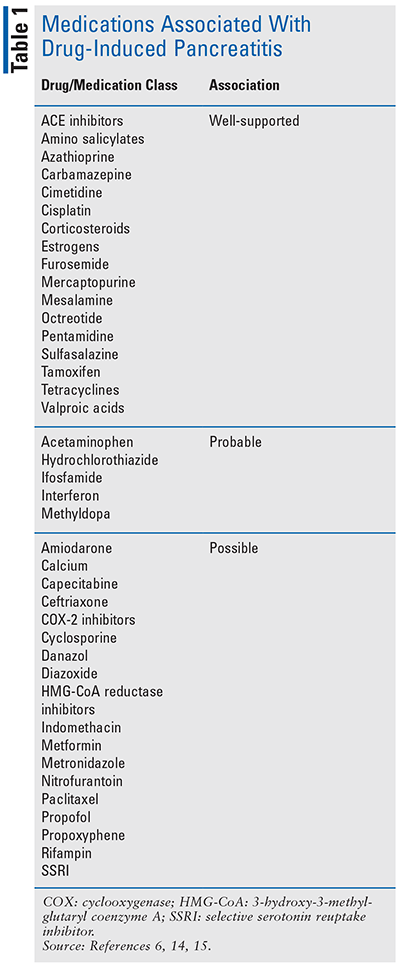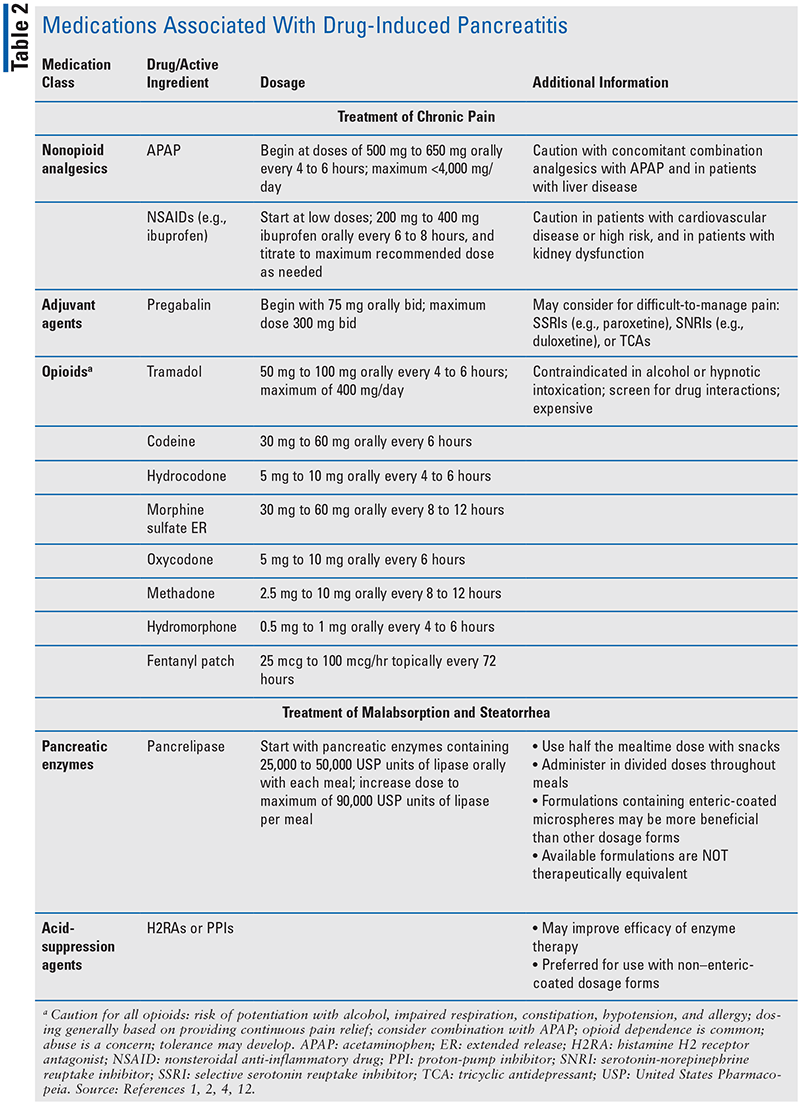US Pharm. 2022;47(12):8-12.
ABSTRACT: Chronic pancreatitis is a progressive condition of the pancreas characterized by long-standing inflammation, abdominal pain, and loss of endocrine and exocrine function. Lifestyle and dietary modifications, management of pain, and replacement of pancreatic enzymes are key strategies in the management of chronic pancreatitis. Treatment goals and plans should be made in conjunction with the patient and individualized based on disease severity and a patient-specific analysis of risks and benefits. Pharmacists are in a unique position to make recommendations based on patient-specific characteristics, promote medication adherence, and monitor for drug interactions and adverse effects.
Pancreatitis is an inflammatory condition of the pancreas with variable involvement of regional tissues or remote organ systems. It can be classified as acute or chronic. The risk of acute pancreatitis progressing to chronic pancreatitis after an initial episode is mainly related to the etiology. Chronic pancreatitis is a progressive condition in which long-standing inflammation leads to loss of pancreatic endocrine and exocrine function.1 Chronic pancreatitis often goes unnoticed for many years. The annual estimated incidence of chronic pancreatitis in the United States is five to eight per 100,000 adults; the estimated prevalence of chronic pancreatitis is 42 to 73 per 100,000 adults.2 The average age of onset for chronic pancreatitis is around 62 years and is 4.5 times more common in males than females. African Americans have a two to three times higher risk of developing chronic pancreatitis than Caucasians and are twice as likely to require hospitalization.3 General risk factors for developing chronic pancreatitis are chronic alcohol consumption, nicotine use, nutritional factors, hereditary factors, efferent duct factors, and immunologic factors.1
Chronic Pancreatitis
The most common symptom of chronic pancreatitis is abdominal pain.1 Other symptoms include diarrhea, oily stool, and weight loss. Chronic pancreatitis can lead to complications such as pseudocysts, pancreatic cancer, loss of islet mass and insulin production, and steatorrhea.3 Diagnosis of chronic pancreatitis usually involves analyzing a patient’s signs and symptoms, as well as visualization of the pancreas by MRI, CT, or both. Endoscopic ultrasound is another method used to diagnose chronic pancreatitis. Endoscopic retrograde cholangiopancreatography (ERCP) also allows for visualization of the pancreas, but this procedure carries more risk than less-invasive procedures and is recommended only in cases requiring surgical intervention.2 Additionally, pancreatic function tests such as secretin or cholecystokinin stimulation can be used when imaging results are ambiguous.4 Patients with chronic pancreatitis may experience acute flares that mimic the symptoms of acute pancreatitis, such as nausea and vomiting, swollen or tender abdomen, fever, and tachycardia.5
Identification and correction of various factors that may contribute to worsening chronic pancreatitis or acute pancreatitis flares are essential when managing pancreatitis patients. A key factor that pharmacists can screen for and monitor is medication-related complications. There are limited data available regarding drug-induced pancreatitis; however, medications should always be considered and consistently monitored.6 Most data related to drug-induced pancreatitis come from case reports and can be found in TABLE 1. Due to patient accessibility and medication expertise, community pharmacists are in a unique position to screen for drug interactions and high-risk medications for this patient population. Additionally, pharmacists remain indispensable as patient educators and play a vital role in ensuring patients are aware of drug interactions, adverse effects, and signs and symptoms of an acute flare.

Treatment
The major goals in the treatment of chronic pancreatitis are management of pain, associated complications, and functional (endocrine and exocrine) insufficiency in order to improve quality of life. This requires a multifaceted approach, including lifestyle modifications, pharmacologic therapy, surgical intervention, and endoscopic management.7 Due to this complex management scheme, an interdisciplinary care team composed of primary care providers, gastroenterologists, surgeons, radiologists, pain specialists, nutritional specialists, and pharmacists is essential for the delivery of optimized, patient-centered care.3
Lifestyle and dietary modifications are key components in the general treatment approach for chronic pancreatitis. Primary lifestyle recommendations include abstinence from alcohol use and smoking cessation. Both have been shown to slow disease progression and reduce the risk of developing disease complications such as pancreatic cancer.8 Pharmacists are well placed to identify barriers, consistently assess patient readiness to quit, and offer clinical services to help patients quit smoking. Dietary recommendations may involve eating small, frequent, low-fat meals to help decrease pain and complications such as steatorrhea.4
Pharmacologic management of chronic pancreatitis is predominantly directed toward controlling pain, treating complications related to pancreatic dysfunction such as malabsorption and steatorrhea, and managing associated conditions, such as diabetes mellitus. TABLE 2 provides information about various pharmacologic agents used in the management of chronic pancreatitis.

Severe abdominal pain is a cardinal symptom, as well as the most challenging component to manage in patients with chronic pancreatitis. High-intensity pain and constant pain significantly reduce quality of life and may result in a higher burden of health resource utilization among these patients.9
Pain associated with chronic pancreatitis appears to be of neuropathic origin, usually presenting as nonspecific abdominal pain. The pain may then progress to a multitude of characterizations, from short relapsing episodes to prolonged persistent pain. It may also alternate between pain patterns regardless of intervention. Nonopioid analgesics are recommended as preferred initial therapy for pain management. Since many of these agents can be found OTC, pharmacists may assist patients with drug selection and appropriate use and may also screen for drug interactions. When initiating any class of analgesic (including opioids), starting low and stopping at the lowest dose that adequately reduces pain is usually recommended. Additionally, for patients taking warfarin and taking acetaminophen chronically (dosages >2 g/day), acetaminophen may increase the international normalized ratio and should be monitored closely.10 Afterward, sequential introduction of adjuvant medications or medications with increasing analgesic capacity should be considered until pain relief is achieved. Opioid analgesics should be reserved for patients with refractory pain.9,11
Adjuvant agents such as antioxidants and pancreatic enzyme supplements have been studied to evaluate their benefit for pain control in patients with chronic pancreatitis. According to the most recent clinical guidelines from the American College of Gastroenterology, antioxidant therapy may be considered to reduce pain but will provide limited benefit. The guidelines recommend against the use of pancreatic enzymes to reduce pain.1
As pancreatic acinar cells become impaired, these cells produce fewer digestive enzymes, resulting in pancreatic insufficiency. Patients may experience difficulty absorbing essential nutrients and dietary fats, often resulting in weight loss and vitamin deficiencies (specifically of fat-soluble vitamins A, D, E, and K). The absence of digestive enzymes may also lead to steatorrhea as fat passes through the intestines undigested.12 Most patients with chronic pancreatitis will require pancreatic enzyme supplementation to achieve adequate nutritional status and to avoid complications such as steatorrhea. As shown in TABLE 2, pancreatic enzymes and fat-soluble vitamin supplementation are preferred treatments for malabsorption. Adequate malabsorption management requires about 10% of normal pancreatic output delivered to the duodenum.4 The replacement dose of lipase required to achieve effective fat absorption may vary from as low as 25,000 United States Pharmacopeia (USP) units to as high as 90,000 USP units with each meal and half that amount with snacks. Timing of administration of replacement enzymes is essential for optimal effect. The dosage should be spread throughout the meal instead of being taken as a single dose.12 If patients continue to suffer from steatorrhea and fail to gain weight, addition of an antisecretory agent (histamine H2 receptor antagonists or proton-pump inhibitors) may be considered to increase the availability of active enzymes in the duodenum.4
Limited data are available comparing conservative therapy (i.e., dietary and lifestyle modifications) with more invasive therapy (i.e., surgical or endoscopic interventions). Therefore, treatment plans and decisions should be individualized and made in conjunction with patients based on disease severity and patient-specific analysis of risk versus benefit.13
Pharmacist’s Role
It is important for pharmacists to have a basic understanding of pancreatitis to adequately assist patients with lifestyle modifications and medication management. Appropriate patient-centered care of those living with chronic pancreatitis requires an interprofessional approach. Pharmacists have a well-established history of providing patient education and effective health interventions. Interventions may include aid with lifestyle and dietary modifications through identification of barriers and creation of tailored strategies based on patient-specific needs. For example, pharmacists have become integral supporters and educators in smoking cessation and medication management. Interventions may also include alleviation of chronic pain, OTC medication counseling, and screening for safety issues such as drug interactions and/or pancreatic enzyme usage and administration. Pharmacists are well positioned to make recommendations based on patient-specific characteristics, promote medication adherence, and monitor for drug interactions and adverse effects.
REFERENCES
1. Gardner TB, Adler DG, Forsmark CE, et al. ACG clinical guideline: chronic pancreatitis. Am J Gastroenterol. 2020;115(3):322-339.
2. Singh VK, Yadav D, Garg PK. Diagnosis and management of chronic pancreatitis: a review. JAMA. 2019;322(24):2422-2434.
3. Vege SS, Chari ST. Chronic pancreatitis. N Engl J Med. 2022;386(9):869-878.
4. Afghani E, Sinha A, Singh VK. An overview of the diagnosis and management of nutrition in chronic pancreatitis. Nutr Clin Pract. 2014;29(3):295-311.
5. Cleveland Clinic. Pancreatitis. June 4, 2020. https://my.clevelandclinic.org/health/diseases/8103-pancreatitis. Accessed September 10, 2022.
6. Hung WY, Lanfranco OA. Contemporary review of drug-induced pancreatitis: a different perspective. World J Gastrointest Pathophysiol. 2014;5(4):405-415.
7. Barry K. Chronic pancreatitis: diagnosis and treatment. Am Fam Physician. 2018;97(6):385-393.
8. Lowenfels AB, Maisonneuve P. Defining the role of smoking in chronic pancreatitis. Clin Gastroenterol Hepatol. 2011;9(3):196-197.
9. Schneider A, Hirth M. Pain management in chronic pancreatitis: summary of clinical practice, current challenges and potential contribution of the M-ANNHEIM classification. Drugs. 2021;81(5):533-546.
10. Acetaminophen [product information]. Bethlehem, PA: B. Braun Medical Inc; February 2021.
11. Drewes AM, Bouwense SAW, Campbell CM, et al. Guidelines for the understanding and management of pain in chronic pancreatitis. Pancreatology. 2017;17(5):720-731.
12. Majumder S, Chari ST. Chronic pancreatitis. Lancet. 2016;387(10031):1957-1966.
13. D’Haese JG, Ceyhan GO, Demir IE, et al. Treatment options in painful chronic pancreatitis: a systematic review. HPB (Oxford). 2014;16(6):512-521.
14. Kaurich T. Drug-induced acute pancreatitis. Proc (Bayl Univ Med Cent). 2008;21(1):77-81.
15. Preiss D, Tikkanen MJ, Welsh P. Lipid-modifying therapies and risk of pancreatitis: a meta-analysis. JAMA. 2012;308(8):804-811.
The content contained in this article is for informational purposes only. The content is not intended to be a substitute for professional advice. Reliance on any information provided in this article is solely at your own risk.
To comment on this article, contact rdavidson@uspharmacist.com.





